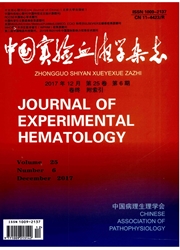

 中文摘要:
中文摘要:
目的:构建单倍体相合造血干细胞移植(HSCT)小鼠急性移植物抗宿主病(aGVHD)模型,并探讨其发病机制。方法:建立以C57BL/6(H-2^b)为供鼠,137Csγ射线11 Gy照射[C57BL/6×CBA/Ca]F1(H-2b×k)为受鼠的单倍体相合造血干细胞移植aGVHD模型。将受鼠随机分为照射对照、去除T细胞的骨髓细胞(TD-BM)、TD-BM+T细胞(1)和TD-BM+T细胞(2)共4组。移植后对受鼠生存期和体重进行评分;比较移植后14 d受鼠的靶器官损伤情况,比较TD-BM和TD-BM+T细胞(1)组的病理评分;比较移植后14和28 d TD-BM和TD-BM+T细胞(1)组的骨髓嵌合率;应用ELISA法分别检测移植后14 d TD-BM和TD-BM+T细胞(1)组受鼠血清中细胞因子IFN-γ、TNF-ɑ和IL-1的浓度。应用流式细胞术检测TD-BM和TD-BM+T细胞(1)组受鼠脾细胞中H-2b+H-2k-CD4+IFN-γ+Th1细胞的百分比和CFSE检测供者T细胞发生的增殖情况。结果:TD-BM、照射对照、TD-BM+T细胞(1)和TD-BM+T(2)组平均活存时间分别为60、13.29±5.50、33±2.35、29.14±1.77 d。移植后14 d,TD-BM+T细胞(1)和TD-BM+T(2)组小鼠出现肝脏、结肠、肺脏和皮肤等多器官损伤,而在TD-BM组多器官损伤不明显。移植后14和28 d,TD-BM和TD-BM+T细胞(1)组小鼠的嵌合率均〉94%。移植后14 d,TD-BM+T细胞(1)受鼠血清中细胞因子IFN-γ、TNF-ɑ和IL-1水平较TD-BM组明显增高。移植后14 d,TD-BM+T细胞(1)组中H-2b+H-2kCD4+IFN-γ+百分比明显高于TD-BM组[(0.5240±0.08447)%vs(7.912±0.6087)%](P〈0.05)。移植后14d,供者T细胞在受者体内发生明显增殖。结论:C57BL/6(H-2b)→[C57BL/6×CBA/Ca]F1(H-2b×k)可作为单倍体相合移植aGVHD的实验模型;Th1细胞在单倍体相合移植aGVHD中可能发挥重要作用。
 英文摘要:
英文摘要:
Objective: To establish the acute graft-versus-host disease( GVHD) mouse model based on haplo identical hematopoietic stem cell transplantation( HSCT) and to further investigate the pathogenesis of GVHD.Methods: Recipient mice( [C57BL/6 × CBA/Ca]F1( H-2~(b×k))) received lethal irradiation( 11 Gy) of γ ray( 137Cs),followed by transplantation with donor-derived [C57BL/6( H-2b) ]T cell-depleted bone marrow cells( TD-BM) with or without donor-derived T cells. Recipients were randomly divided into 4 groups,including irradiation group,TD-BM group,TD-BM + T cell group 1 and TD-BM + T cell group 2. Survival rate and weight change were detected after HSCT. Pathological scoring were performed on the collected organs from recipients on day 14. Moreover,bone marrow chimerism was detected on days 14 and 18 after HSCT. Additionally,differentiation of donor-derived T cells towards Th1 cells in vivo was analyzed by flow cytometry. Furthermore,proliferation of donor-derived T cells in vivo was tested using CFSE. Results: The average survival in TD-BM,irradiation,TD-BM + T cell group 1 and TD-BM + T cell groups 2 were 60,13. 29 ± 5. 50,33 ± 2. 3 and 29. 14 ± 1. 77 days,respectively. On day 14 after transplantation,recipients of TD-BM + T cell group 1 displayed significantly more severe pathology in liver,colon,lung and skin. Ondays 14 and 28 after HSCT,bone marrow chimerism in recipients of both TD-BM group and TD-BM + T cell groups 1was over 94%. On day 14 after HSCT,serum cytokines IFN-γ,TNF-ɑ and IL-1 levels in TD-BM + T cell group 1 were significantly higher than those in TD-BM group. Percentage of H-2b + H-2k-CD4 + IFN-γ + in spleen cells of recipients in TD-BM + T cell group 1 was higher than that of TD-BM group,with( 0. 5240 ± 0. 08447) % vs( 7. 912 ± 0. 6087) %( P〈0. 05). On days 14 after HSCT,donor-derived T cells displayed obvious proliferation in vivo. Conclusion:C57BL/6( H-2b) →[C57BL/6 × CBA/Ca]F1( H-2b × k) HSCT mod
 同期刊论文项目
同期刊论文项目
 同项目期刊论文
同项目期刊论文
 期刊信息
期刊信息
